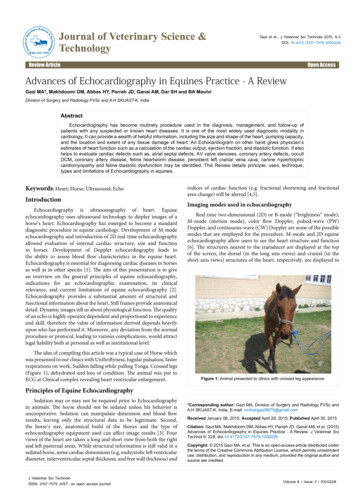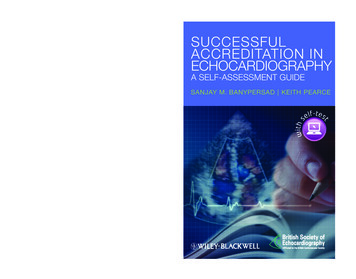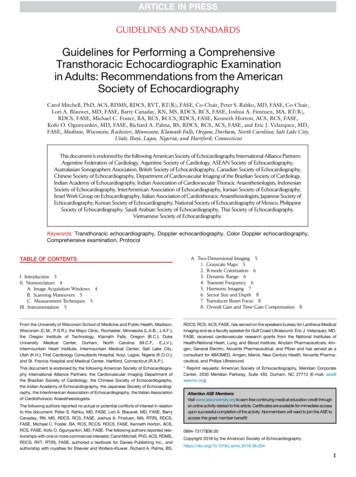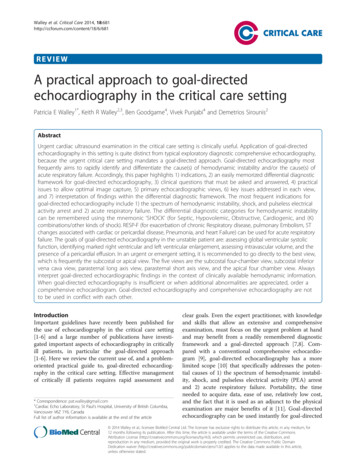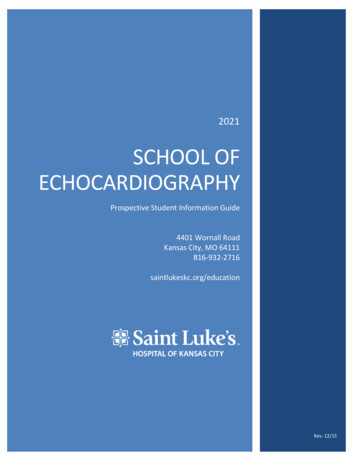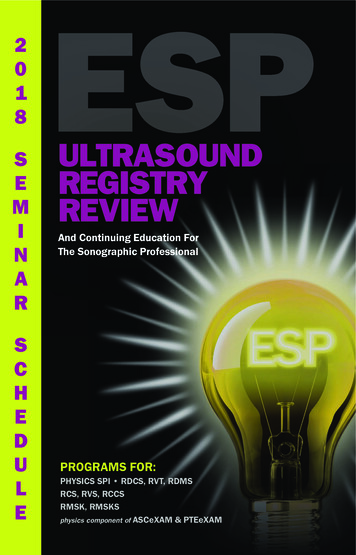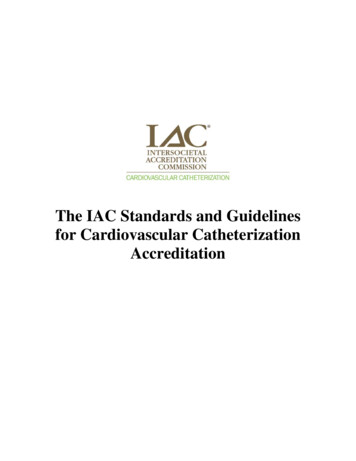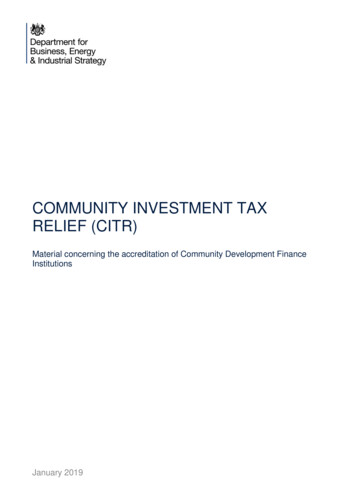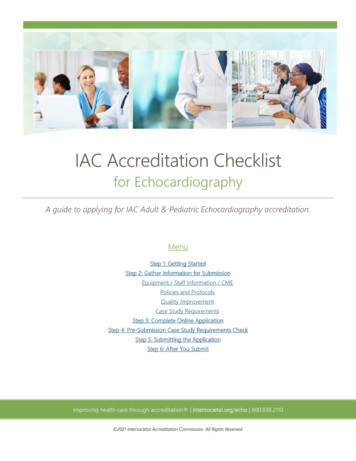
Transcription
IAC Accreditation Checklistfor EchocardiographyA guide to applying for IAC Adult & Pediatric Echocardiography accreditation.MenuStep 1: Getting StartedStep 2: Gather Information for SubmissionEquipment / Staff Information / CMEPolicies and ProtocolsQuality ImprovementCase Study RequirementsStep 3: Complete Online ApplicationStep 4: Pre-Submission Case Study Requirements CheckStep 5: Submitting the ApplicationStep 6: After You SubmitImproving health care through accreditation intersocietal.org/echo 800.838.2110 2021 Intersocietal Accreditation Commission. All Rights Reserved.
Step 1: Getting StartedReview the IAC Standards and Guidelines for (Adult or Pediatric) Echocardiography AccreditationThe Standards are the basis for the IAC Echocardiography accreditation program and can be downloaded standards. These Standards define the complete, minimumrequirements for which an accredited facility is held accountable.Perform a Thorough Facility Self-AssessmentPrior to beginning the accreditation application, applicant facilities should review current policies, protocols andfinal reports to ensure compliance with the IAC Standards.Create or Access Existing IAC Online Accreditation AccountTo access the IAC Online Accreditation application, login to your existing account (iaconlineaccreditation.org) orcreate a new IAC Online Accreditation account (if you’re a first-time applicant). To learn more about accessing orcreating an Online Accreditation account, please visit e.aspx.Step 2: Gather Information for SubmissionEquipment Information (manufacturer, model and year)Procedure Volumes (estimated annual facility and staff procedure volume information)Training/Experience Qualification Pathways for Physicians and SonographersCertificate/Credential Information (i.e., NBE, ABIM/ABP certificate(s) for physicians, RDCS, RCCS or RCS forsonographers [including dates and certificate/registry numbers])Physician Medical License (for each state the interpreting physician is licensed to practice must be kept on file)An Estimate of the Number of Studies Interpreted by the Medical Director and Every Medical Staff MemberContinuing Medical Education (CME) Information for All Staff (must be kept on file and available for submission tothe IAC upon request): Medical Director(s)* – Required to have 30 hours CME relevant to cardiac imaging over a period of threeyears. At least 15 hours must be echocardiography related. Medical Staff* – Required to have 15 hours CME relevant to cardiac imaging over a period of three years.At least 5 hours must be echocardiography related.*Must be earned within the three-year period prior to application submission, even if they are new to the facility. Technical Director and Technical Staff – Required to have at least 15 hours of cardiac imaging-relatedCME during their credentialing triennial cycle.Helpful Resource – Continuing Education (CE/CME) FinderLooking for CE/CME? Visit the CE/CME course calendar on the IAC website to search through a robustcalendar of in-person, virtual and on-demand courses.IAC Echocardiography Accreditation Checklist (Updated 10-1-2021)Page 2
Policies and ProtocolsInfection Control Policy - A policy to ensure appropriate precautions to protect both patients and facilitypersonnel are taken, in accordance with universal precautions.Critical Results Communication Policy - A policy that outlines the steps taken for communication of criticalfindings to the referring provider.Primary Source Verification Policy - A policy for verifying all medical and technical staff member credentialsthrough the applicable issuing agencies.Patient Complaint Policy - A policy that outlines the process for patients to issue a complaint/grievance inreference to the care/services they received at your facility.Personnel Safety Policy (Ergonomics) - A policy must be in place to address technical staff safety, comfort andavoidance of work-related musculoskeletal disorders (MSD).Radiation Safety Policy (if applicable) - A policy to ensure employee safety when in the presence of ionizing radiation.Preliminary vs. Final Report Policy (if applicable) - A policy that explains what steps are taken regarding notification ofthe referring physician or other medical personnel when there is a difference between the preliminary and final reports.Policy for Use of Ultrasound Enhancing Agents (UEAs) (if applicable) - A policy for the facility’s use of UEAs includingbut not limited to; indications, administration, ultrasound system settings, monitoring for hypersensitivity reactions,and training.Policy for Recommended Alternative Imaging (Adult Echo only) - When Ultrasound Enhancing Agents (UEAs)cannot be used or the UEA does not provide adequate visualization, a policy must exist for recommendedalternative imaging.Policy for cleaning/decontaminating and leakage testing of TEE transducer (if applicable).Moderate Sedation Policies (if applicable) - Written policies must exist for the use of moderate sedation including,but not limited to training requirements for personnel providing moderate sedation; monitoring of vital signs andlevel of consciousness during and after the examination and; type of sedatives and appropriate dosing.Facility-Specific, Step-by-Step Technical Protocols - For all modalities (TTE, TEE, SE and Fetal) the facility isapplying for accreditation.Quality Improvement (QI) Policy - A written policy regarding QI that includes all procedures (TTE, TEE, SE andFetal) performed in the facility.QI MeasuresTest Appropriateness - A minimum of two cases per modality (TTE, TEE, SE) per quarter must be evaluated for theappropriateness of the test performed and categorized as: appropriate/usually appropriate; may be appropriate;or rarely appropriate/usually not appropriate.IAC Echocardiography Accreditation Checklist (Updated 11-5-2021)Page 3
Interpretive Quality Review (Physician Interpretation Variability) - A minimum of two cases per modality (TTE, TEE,SE, Fetal) per quarter must be evaluated for the quality and accuracy of the interpretation based on the acquiredimages. The cases must represent as many physicians as possible. Differences in interpretation must be reconciledto achieve uniform examination interpretation.Technical Quality Review (Sonographer Performance Variability) - Two cases per modality (TTE, TEE, SE, Fetal) perquarter must be reviewed for image quality, completeness of the study and adherence to the facility protocol tobe reviewed in QI meetings. The cases must represent as many sonographers as possible. Discrepancies inacquisition quality and variability must be reconciled to achieve uniform examination quality.Final Report Completeness and Timeliness - A minimum of two cases per modality (TTE, TEE, SE, Fetal) per quartermust be evaluated for completeness and timeliness of the final report as required in the Standards (refer toStandards 3.2A, 3.2.4A for report completeness and Standards 3.3A through 3.6A for report timeliness). Thereports must represent as many physicians as possible. IAC Echocardiography now accepts applicableImageGuideEcho Registry reports as QI documentation for the report completeness and timeliness QI measure.Correlation (Pediatric Only) - Must be performed with any appropriate imaging modality, surgical findings orclinical outcomes for a minimum of four cases annually with at least two cases per relevant testing area to bereviewed in QI meetings.Helpful Resource – Sample Document RepositorySample versions of policies and protocols listed above can be found in the IAC Sample Document Repository Select Adult or Pediatric Echocardiography under modality or use the search bar.Case Study RequirementsCase study submissions are required to assess the interpretative and technical quality of the facility. All details of the cardiacanatomy should be visualized adequately. It is understood that technical limitations will occasionally limit the sonographer'sability to adequately define cardiac structures and visualize the myocardium when performing TTE; however, therepresentative transthoracic cases submitted for review should demonstrate all appropriate views of the facility's protocoland be of above-average examination quality. All cases must be complete examinations; limited exams are not acceptable.Adult Transthoracic (ATTE):5 or fewer staff 4 cases per facility (2 AS, 2 LV)*6 to 8 staff 6 cases per facility (3 AS, 3 LV)*9 to 15 staff 8 cases per facility (4 AS, 4 LV)*16 to 25 staff 10 cases per facility (5 AS, 5 LV)*Greater than 25 staff 12 cases per facility (6 AS, 6 LV)**LV are cases of regional wall motion abnormalities due to coronary artery disease or myocardial infarction, not global LV dysfunction or diastolicdysfunction cases. Cases demonstrating Takotsubo cardiomyopathy (stress cardiomyopathy) with regional abnormalities will also be accepted. AScases must be native valvular AS with a velocity of at least 2 m/sec. When submitting case studies, try to represent as manyCURRENT staff members as possible without duplicating.Cases submitted with the application must not beindependently performed by sonographer or physician trainees.One case study must be submitted from the TechnicalDirector.Medical Director must be represented.IAC Echocardiography Accreditation Checklist (Updated 10-1-2021) All cases must be complete examinations;limited exams are not acceptable.All cases must be selected from within the past12 months from the date of application filing.The same case may not be submitted twicewithin a testing section.Page 4
Adult Stress:The required stress case studies are based on the total number of staff (medical and technical) that perform/interpret stressecho in the applicant facility. The following are the required number of stress case studies per base facility:5 or fewer staff 4 cases per facility6 to 8 staff 6 cases per facility9 to 15 staff 8 cases per facility16 to 25 staff 10 cases per facilityGreater than 25 staff 12 cases per facility Any one of the following types of cases is acceptablefor submission: (1) abnormal wall motion at rest dueto coronary artery disease or myocardial infarction,OR (2) inducible wall motion abnormality due tocoronary artery disease or myocardial infarction, OR(3) a stress case using contrast (may be normal orabnormal).When submitting case studies try to represent asmany CURRENT staff members as possible withoutduplicating. One case study must be submitted from the TechnicalDirector.Medical Director must be represented.All cases must be selected from within the past 36 monthsfrom the date of application filing.The same case may not be submitted twice within a testingsection.Cases submitted with the application must not beindependently performed by sonographer or physiciantrainees.Adult Transesophageal (ATEE) One complete adult TEE case (that includes all standard views and Doppler assessments) for each physician thatperforms TEE.Cases submitted with the application must not be independently performed by physician trainees.TEE representative cases must have an indication or finding of significant mitral regurgitation or suspected cardiacsource of embolus. At least one representative case from the facility must have a finding of significant mitralregurgitation.All cases must be selected from within the past 12 months from the date of application filing.The same case may not be submitted twice within a testing section.Note: Although “limited” or shorter pathology-directed TEE exams may be appropriate in some circumstances, these are notthe types of cases that should be submitted for the purpose of facility accreditation review. Intraoperative TEE may besubmitted if the facility physician performed the entire study including: Passing the probeImage acquisition and documentationReportingImaging archiving on echocardiography laboratory archiving systemPediatric Transthoracic (PTTE):The required pediatric TTE case studies are based on the total number of staff (medical and technical that perform andinterpret pediatric transthoracic echocardiograms) in an applicant facility. The following are the required number of pediatricTTE case studies per base facility:5 or fewer 4 cases per facility (2 shunts, 1 simple obstruction, 1 complex defect)6 to 8 staff 6 cases per facility (2 shunts, 2 simple obstructions, 2 complex defects)9 to 15 staff 8 cases per facility (4 shunts, 2 simple obstructions, 2 complex defects)16 to 25 staff 10 cases per facility (4 shunts, 3 simple obstructions, 3 complex defects) 25 staff 12 cases per facility (4 shunts, 4 simple obstructions, 4 complex defects)[CONTINUED ON NEXT PAGE]IAC Echocardiography Accreditation Checklist (Updated 10-1-2021)Page 5
All cases must be abnormal.When submitting case studies try to represent as manyCURRENT staff members as possible without duplicating.Cases submitted with the application must not be independentlyperformed by sonographer or physician trainees.One case study must be submitted from the Technical Director.Medical Director must be represented.All cases must be complete examinations.Types of Cases to be Submitted: Initial studies demonstrating un-repaired defects are preferred.However, repaired defects will be accepted if the facility isunable to submit initial studies.All cases must be selected from within the past 12 months fromthe date of application filing.The same case may not be submitted twice within a testing section. Shunt lesions (i.e., atrial septal defects, ventricularseptal defects or patent ductus arteriosus)Complex defects (i.e., shunt lesions plus anobstruction, mitral or tricuspid atresia,atrioventricular canal defect, Tetralogy of Fallot,ventricular hypoplasia, anomalous coronaryartery, truncus arteriosus, interrupted aortic arch)Simple obstruction (i.e., aortic and/or pulmonaryvalve stenosis, coarctation of the aorta)Pediatric Transesophageal (PTEE):First-Time Application:1 case per physician that includes a complete examination (notfocused/limited) including all the views listed in the Standards. Cases submitted with the application must not beindependently performed by physician trainees.All cases must be selected from within the past 36 monthsfrom the date of application filing.The same case may not be submitted twice within a testingsection.Reaccreditation Application: It is recognized that manyTEEs are performed in situations (i.e., in the OR orinterventional catheterization suite) that may limit orprevent complete evaluation due to time constraints orare focused studies to answer specific clinical questions.For these reasons, physicians in facilities that are applyingfor reaccreditation may submit: 1 case per physician which may be a focusedexamination, (if represented with a completeexamination on the previous application) or1 case per physician which must be a completeexamination (if physician is new to the facility and notrepresented with a complete examination performedin the facility as part of a previous application)All cases must be selected from within the past 36months from the date of application filing.Fetal:The required fetal case studies are based on the total number of staff (medical and technical) in an applicant facility. Thefollowing are the required number of fetal case studies per facility:5 or fewer 4 cases per facility (1 shunt, 1 simple obstruction, 1 case with an indication or finding of fetal arrhythmia and 1 caseof hypoplastic ventricle)6 to 8 staff 6 cases per facility (2 shunts, 2 simple obstructions, 1 case with indication or finding of fetal arrhythmia and 1 caseof hypoplastic ventricle)9 to 15 staff 8 cases per facility (4 shunts, 2 simple obstructions, 1 case with an indication or finding of fetal arrhythmia and 1case of hypoplastic ventricle)16 to 25 staff 10 cases per facility (4 shunts, 3 simple obstructions, 1 complex defect, 1 case with an indication or finding offetal arrhythmia and 1 case of hypoplastic ventricle) 25 staff 12 cases per facility (4 shunts, 4 simple obstructions, 2 complex defects, 1 case with an indication or finding of fetalarrhythmia and 1 case of hypoplastic ventricle) Cases submitted with the application must not be independently performed by sonographer or physician trainees.All cases must be selected from within the past 12 months from the date of application filing.The same case may not be submitted twice within a testing section.IAC Echocardiography Accreditation Checklist (Updated 10-1-2021)Page 6
Multiple Sites:If an application includes one or more multiple sites, the following cases are required in addition to the base facility casestudies outlined for each testing area:Adult Facility: Pediatric Facility:1 abnormal TTE (AS or LV case*) from each site.1 representative Adult TEE case and its final report foreach physician that performs TEE at the multiple site,unless previously represented at the main site (ifapplicable).1 stress echocardiogram from each site. Any one of thefollowing types of cases is acceptable for submission;abnormal wall motion at rest due to coronary arterydisease or myocardial infarction, inducible wall motionabnormality due to coronary artery disease or myocardialinfarction or a stress case using contrast (may be normalor abnormal). 1 abnormal PTTE; any one of the following types of casesare acceptable for submission; shunt, simple obstruction,or complex defect.1 representative PTEE case and its final report for eachphysician that performs PTEE at the multiple site, unlesspreviously represented at the main site.1 abnormal fetal case study from each site (if applicable);any one of the following case types is acceptable forsubmission; complex defect, fetal arrhythmia, shunt,simple obstruction, or hypoplastic ventricle.*LV are cases of regional wall motion abnormalities due to coronaryartery disease or myocardial infarction, not global LV dysfunction ordiastolic dysfunction cases. Cases demonstrating Takotsubocardiomyopathy (stress cardiomyopathy) with regional abnormalitieswill also be accepted. AS cases must be native valvular AS with avelocity of at least 2 m/sec.For details and instructions on case study image submission, please visit Step 3: Complete Online ApplicationIAC Online Accreditation has two major aspects: an account profile and an application questionnaire. Aftercompleting required fields and sections of the account profile (Manage Staff, Manage Sites and ManageEquipment), proceed to the questionnaire by clicking the Applications tab.It is within the questionnaire that applicant facilities will provide detailed information about the facility and uploadthe supporting documentation (detailed above in Step 2). For facilities applying for reaccreditation, the IACQuickFill Reaccreditation feature retains and copies previous application data into your reaccreditationapplication.When the questionnaire is completed, the [Begin Pre-submission Check] button is presented on the Conclusionscreen. Once the pre-submission case requirements check is initiated, changes to the application are notpermitted unless the IAC staff find errors in the case selection.IAC Echocardiography Accreditation Checklist (Updated 10-1-2021)Page 7
Step 4: Pre-Submission Case Study Requirements CheckAbout two weeks prior to the expected final submission date, the pre-submission case study requirements checkmust be initiated. IAC staff will review case study documentation in the application to ensure accurate case studyselection, staff and site representation.Facilities will receive an e-mail from the IAC, within two business days, to update their case study documentation,as requested or proceed to final submission.The check is performed to provide a more efficient application submission and review process for the facility.Case study images should not be uploaded until the pre-submission case study check is complete.Once the pre-submission case study requirements check has been completed and any errors rectified, you willproceed to final submission via the conclusion screen of the online application and submit case study.Step 5: Submitting the ApplicationDuring final submission, the payment method will be selected, and you will be instructed to upload the case studyimages and fee* (if paid by check) within 5 business days.Effective January 1, 2021, shipped case study materials are no longer accepted. Facilities are now required toupload all materials through IAC’s HIPAA-compliant, secure medical imaging sharing service.For more details on uploading cases, please visit .*The application fee paid during final submission covers the three-year accreditation cycle. View the complete fee structure program-fees.Step 6: After You SubmitAfter submission, the application is locked and becomes your final application submission. A read-only copy ofthe submitted application questionnaire is accessible by using the Applications link (click on Online ApplicationTools icon) in your Online Accreditation account.Upon submission of the application and case studies the IAC will begin the internal review process. The internalreview, peer review and board review are conducted prior to a decision being rendered.The application review process takes approximately 8 to 10 weeks* to complete. The accreditation decision will beprovided to the facility via a notification letter that may be downloaded from the Online Accreditation account.*For expedited applications, ensure that the case study images are received by the IAC within two business days after finalsubmission of the application.Helpful Resource – Quick LinksUpcoming Webinars On Demand Webcasts Marketing Your IAC AccreditationIAC Echocardiography Accreditation Checklist (Updated 11-5-2021)Page 8
IAC Echocardiography Accreditation Checklist (Updated 10-1-2021) Page 2 . Step 1: Getting Started . Review the IAC Standards and Guidelines for (Adult or Pediatric) Echocardiography Accreditation . The . Standards. are the basis for the IAC Echocardiograph
